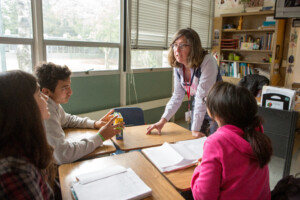Urban showdown coming in RttT states
While bloggers were disappointed by a series of blob-friendly compromises, I’m mostly bullish on final RttT language primarily for an important clause that will result in real improvement in the nation’s worst schools.
Flypaper said, “It appears high inspiration was tempered by the various and messy forces of politics and policy-making. EduWonk suggests, “The anticipation may well have leveraged more state-level change than the actual program will. Eduflack noted the emphasis on prior accomplishment versus plan
But here’s the big deal, buried in a parenthetical, on page 10 of the Executive Summary is this little gem, “LEA with more than nine persistently lowest-achieving schools may not use the transformation model for more than 50 percent of its schools.” The definition of ‘lowest-achieving’ is complicated (below) and states have some latitude but the net result will be lots of disruptive urban high school work.
Most urban districts will have more than 9 of the lowest performing schools in their state and will be prohibited from DIY ‘transformations.’ That means a lot of turnarounds (which require 50% staff turnover) and closure restarts—far more disruptive but far more likely to result in real improvement. I wish ED had just prohibited DIY for every school in ‘needs improvement for more four or more years but this is big.
Lots of high schools are likely to fall into state failing school lists given 60% grad rate hurdle. They’ll also face the challenge of meeting real college ready standards. The combination means we need lots of good new high schools and lots of support and options for high school kids.
Participating districts are required to sign an MOU agreeing to RttT participation. We’ll see a bunch of urbans attempt to sit this out rather than undergo massive surgery. However, states can make sure it’s not optional by actually exercising their authority under that bill passed in 2001 (NCLB). There are some signs of progress on this front—Illinois is following Pastoreks’ lead with an RFP for a euphemistically titled Partnership Zone (which really means ‘you lost the right to manage this school.). Combined with the School Improvement Grants, we should see a lot of disruptive work and lot of urban controversy.
Can’t resist, here’s seven things I don’t like:
- It’s like a Kippathon—solid but old fashioned and expensive. RttT ignores online learning which will serve 6-7% of kids when it’s done with virtual and blended solution (and it could have been 15-20%).
- Seems lame to make the vision statement worth 65 points (13%) but it does requires MOUs from participating districts.
- There’s only 10 points for high quality assessment; we’ll need to rely on the allocated $350M for progress here (I’m not optimistic that this will be as forward leaning as it should be).
- Those squishy ‘other innovative schools’ that snuck into the charter language (giving false hope to states like Washington that don’t have charters)
- Only 10 points for state interventions in low performing schools and districts—guess we won’t see much of that.
- Equitable funding is only worth 10 points—guess Illinois still has a shot.
- Lots of qualitative stuff, so it’s all up to those mysterious readers
And for your homework, read this definition six times and write a comment about its implications (and tell me what it really means):
Persistently lowest-achieving schools means, as determined by the State:
(i) Any Title I school in improvement, corrective action, or restructuring that
(a) Is among the lowest-achieving five percent of Title I schools in improvement, corrective action, or restructuring or the lowest-achieving five Title I schools in improvement, corrective action, or restructuring in the State, whichever number of schools is greater; or
(b) Is a high school that has had a graduation rate as defined in 34 CFR 200.19(b) that is less than 60 percent over a number of years; and
(ii) Any secondary school that is eligible for, but does not receive, Title I funds that
(a) Is among the lowest-achieving five percent of secondary schools or the lowest-achieving five secondary schools in the State that are eligible for, but do not receive, Title I funds, whichever number of schools is greater; or
(b) Is a high school that has had a graduation rate as defined in 34 CFR 200.19(b) that is less than 60 percent over a number of years.
To identify the lowest-achieving schools, a State must take into account both
(i) The academic achievement of the “all students” group in a school in terms of proficiency on the State’s assessments under section 1111(b)(3) of the ESEA in reading/language arts and mathematics combined; and
(ii) (ii) The school’s lack of progress on those assessments over a number of years in the “all students” group.








0 Comments
Leave a Comment
Your email address will not be published. All fields are required.